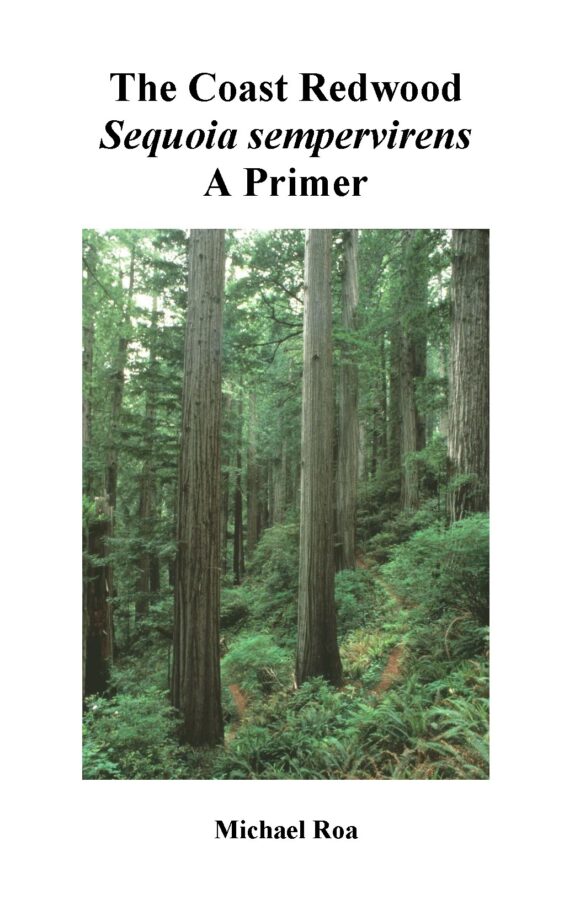Learn About the Local Coast Redwood Forests
Many great resources have been created about the coast redwoods and the movement to protect them.
WATCH
- Under the Redwoods: A Webinar Series with Sempervirens Fund
- Watch Sempervirens Fund on the OpenRoad with Doug McConnell
- Redwoods, Climate Change and Carbon Banks – Sempervirens Fund’s Laura McLendon
- Redwoods and Climate Change – KQED’s Quest program
- Science on the SPOT: Measuring Redwood Giants – KQED’s Quest program
- Exploring the tallest trees – National Geographic
READ

Click here for the printable PDF of The Coast Redwood Sequoia sempervirens: A Primer. Click here for a screen-readable version.
The author, Mike Roa, has a limited number of printed copies of the Primer that he can send for just the cost of postage, which is currently $2.44 for one and $3.28 for two. Contact him at mikeroa46 @ gmail.com.
Books for Adults
Fiction
The Overstory by Richard Powers. W.W. Norton, 2018. The Overstory, winner of the Pulitzer Prize in Fiction, is a sweeping, impassioned work of activism and resistance that is also a stunning evocation of—and paean to—the natural world.
Non-Fiction
A Darker Wilderness: Black Nature Writing from Soil to Stars edited by Erin Sharkey, Milkweed Editions, 2023. In this collection of personal essays, writers reflect on the significance of nature in their lived experience and explore stories spanning hundreds of years and thousands of miles, finding rich Blackness everywhere.
All That the Rain Promises and More: A Hip Pocket Guide to Western Mushrooms by David Arora. Ten Speed Press, 1991. An illustrated guide to identifying 200 Western mushrooms – whether edible, poisonous, or medicinal – by their key features.
California Forests and Woodlands: A Natural History by Verna R. Johnston. University of California Press, 1996. Gorgeous illustrations and photographs accompany vivid descriptions of the ecology of each of the state’s dominant forest types, including redwood forests.
Coast Redwood: A Natural and Cultural History by Michael G. Barbour (Ed.), John Evarts (Ed.), Marjorie Popper (Ed.). Cachuma Press, 2001. This handsome book covers the entire range of coast redwood from the Big Sur coast to the southwestern corner of Oregon and offers a comprehensive account of the ecology and human history of earth’s tallest tree.
Elderflora: A Modern History of Ancient Trees by Jared Farmer, Hachette Book Group, 2022. Farmer explores the complex history of the world’s oldest trees. In a changing climate, a long future is still possible, Farmer shows, but only if we give care to young things that might grow old.
Ever Green: Saving Big Forests to Save the Planet by John W. Reid and Thomas E. Lovejoy. W. W. Norton & Company, 2022. Reid and Lovejoy offer practical solutions to address the biggest challenges our biggest forests face, from vastly expanding protected areas, to supporting Indigenous forest stewards, to planning smarter road networks. In gorgeous prose that evokes the majesty of these ancient forests along with the people and animals who inhabit them, Reid and Lovejoy take us on an exhilarating global journey.
Finding the Mother Tree: Discovering the Wisdom of the Forest by Suzanne Simard. Random House, 2021. Suzanne Simard is a pioneer on the frontier of plant communication and intelligence. Now, in her first book, Simard brings us into her world, the intimate world of the trees, in which she brilliantly illuminates the fascinating and vital truths--that trees are not simply the source of timber or pulp, but are a complicated, interdependent circle of life; that forests are social, cooperative creatures connected through underground networks by which trees communicate their vitality and vulnerabilities with communal lives not that different from our own.
Forest Euphoria: The Abounding Queerness of Nature by Patricia Ononiwu Kaishian, 2025. Kaishian shows us the making of a scientist and introduces readers to the queerness, literal and otherwise, of all the life around us. Fungi, we learn, commonly have more than two biological sexes—and some as many as twenty-three thousand. Some intersex slugs mutually fire calcium carbonate “love darts” at each other during courtship. Glass eels are sexually undetermined until their last year of life, which stumped scientists once dubbed “the eel question.” Nature, Kaishian shows us, is filled with the unusual, the overlooked, and the marginalized—and they have lessons for us all.
The Hidden Life of Trees: What They Feel, How They Communicate―Discoveries from A Secret World (The Mysteries of Nature) by Peter Wohlleben. Greystone Books, 2016. Drawing on groundbreaking new discoveries, Wohlleben presents the science behind the secret and previously unknown life of trees and their communication abilities; he describes how these discoveries have informed his own practices in the forest around him.
Rare Bird: Pursuing the Mystery of the Marbled Murrelet by Maria Mudd-Ruth. Mountaineers Books, 2005. Part naturalist detective story and part environmental inquiry, this book celebrates the fascinating world of an endangered seabird that depends on the contested old-growth forests of the Pacific Northwest for its survival.
The Redwood Forest: History, Ecology, and Conservation of the Coast Redwoods by Reed F. Noss. Save the Redwoods League, 1999. This book provides powerful scientific evidence arguing for ecosystem-level conservation of the coast redwoods.
Remarkable Trees of the World by Thomas Pakenham. WW Norton, 2002. Stunning photography and descriptions of unique trees, including redwoods, can be enjoyed in this photo essay.
The Sempervirens Story: A Century of Preserving California’s Ancient Redwood Forest, 1900-2000 by Willie Yaryan and Denzil and Jennie Verado. Sempervirens Fund Press, 2000. This book contains many contemporary and archival photographs and is an intimate historical narrative about the Sempervirens Fund and its predecessor organization, Sempervirens Club. Purchase your own copy here.
Song of the Redwood Tree by Walt Whitman in Leaves of Grass, 1891-2. Poet Walt Whitman sings of redwood forests as he writes about an emerging America after the Civil War.
Tending the Wild: Native American Knowledge and the Management of California’s Natural Resources by M. Kat Anderson. University of California Press, 2005. Marvelously detailed and beautifully written, Tending the Wild is an unparalleled examination of Native American knowledge and uses of California’s natural resources that reshapes our understanding of native cultures and shows how we might begin to use their knowledge in our own conservation efforts.
Water Always Wins: Thriving in an Age of Drought and Deluge by Erica Gies, The University of Chicago Press, 2022. Our world is not stable—and it is changing in ways that expose the deep dysfunction of our relationship with water. Gies reminds us that figuring out what water wants—and accommodating its desires within our human landscapes—is now a crucial survival strategy.
What If We Get It Right: Visions of Climate Futures by Ayana Elizabeth Johnson, 2024. Sometimes the bravest thing we can do while facing an existential crisis is imagine life on the other side. This provocative and joyous book maps an inspiring landscape of possible climate futures. With clear-eyed essays, vibrant interviews, data, poetry, and art, Johnson guides us through solutions and possibilities at the nexus of science, policy, culture, and justice.
Who Saved the Redwoods: The Unsung Heroines of the 1920s Who Fought for Our Redwood Forests by James Wasserman and Laura Wasserman. Algora Publishing 2019. This history of the early 1900s recalls the Progressive Era crusades of women and men who prevailed against great odds, protecting the best of California’s northern redwood forests.
Wild Trees: A Story of Passion and Daring by Richard Preston. Random House, 2007. This account is a unique perspective from those who climb the giants and grow to love them and their place in the biosphere.
Books for Children
Fiction
A Voice for the Redwoods by Loretta Halter. Polar Bear & Company, 2003. Its vivid depictions of the drama of life and death among the forest’s plants and animals, entertain young readers while also presenting the biology of a tree’s life functions and growth stages, as well as the interrelationships of plants and animals in the forest ecosystem.
The Fire That Saved the Forest by Mike Donahue. Roberts Rinehart Publishers, 2002. When Bernie the bear and his other animal cohorts make a practice of extinguishing every fire that starts in the forest, they realize that the trees are choking out open meadows and not allowing berry bushes and other foods they depend on to grow.
Operation Redwood by S. Terrell French. Amulet Books, 2009. This book tells the story of Julian Carter-Li and his friends as they race to stop Julian’s uncle and his company from cutting down some of California’s oldest redwood trees.
Redwoods by Jason Chin. Flash Point, 2009. Factual text and imaginative illustrations combine to provide a memorable picture book adventure in the redwood forest.
The Giving Tree by Shel Silverstein. Harper Collins, 2014. A story of unforgettable perception, beautifully written and illustrated by the gifted and versatile Shel Silverstein, has been a classic favorite for generations. (Although not about a redwood tree, this book inspired a lifelong dedication to protecting forests and our natural resources for at least one staff member)
Non-Fiction
Braiding Sweetgrass for Young Adults: Indigenous Wisdom, Scientific Knowledge, and the Teachings of Plants by Robin Wall Kimmerer and adapted by Monique Gray Smith, 2022. This new edition reinforces how wider ecological understanding stems from listening to the earth’s oldest teachers: the plants around us.
The Ever-living Tree, the Life and Times of a Coast Redwood by Linda Vieira. Walker, 1994. The two-thousand-year life story of a redwood tree is chronicled with illustrations by Christopher Canyon.
Extreme Scientists: Exploring Nature’s Mysteries from Perilous Places by Donna M. Jackson. Houghton Mifflin, 2009. One of the three extreme scientists profiled here is Stephen Sillett, who does research in the canopies of the tallest redwood trees.
In the Company of Redwoods by David Casterson. Natural Sight Press, 2014. An interactive guide to learning 50 Redwood community plants.
Seabird in the Forest: The Mystery of the Marbled Murrelet by Joan Dunning. Boyds Mills Press, 2011. In this exquisitely illustrated book that won the Science Books & Films Prize for Excellence in Science Books, Joan Dunning presents the amazing story of the marbled murrelet based on dramatic facts uncovered in the last few decades.
Tall Tall Tree by Anthony D. Fredericks. Dawn Publications, 2017. Tony Frederick’s playful rhyme makes this a book young children will want to look at and listen to again and again, while early readers will enjoy reading it on their own.
Welcome to Redwood National and State Parks by M.J. Cosson. The Child’s World, 2007. This photo tour of northern California state and national parks introduces redwood trees in their ecosystem.


